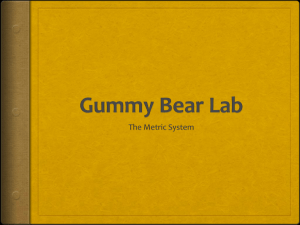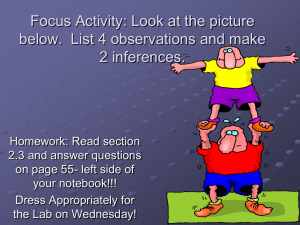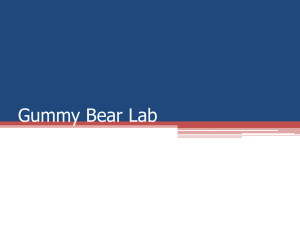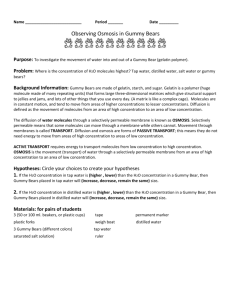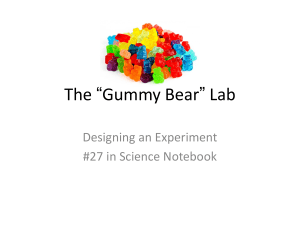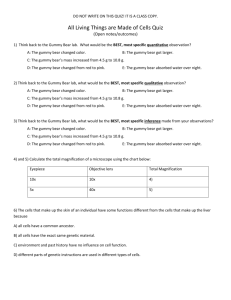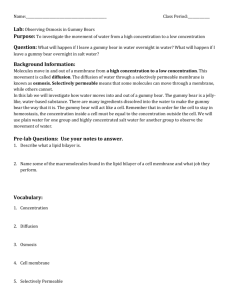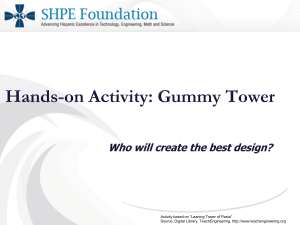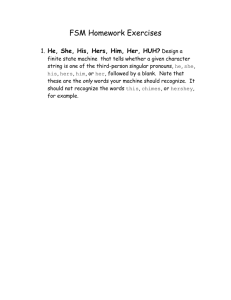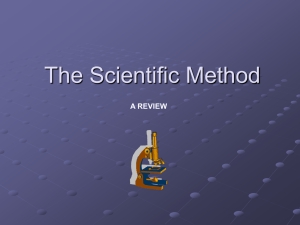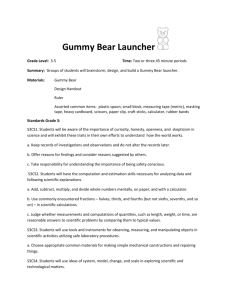Gummy Bear Lab
advertisement
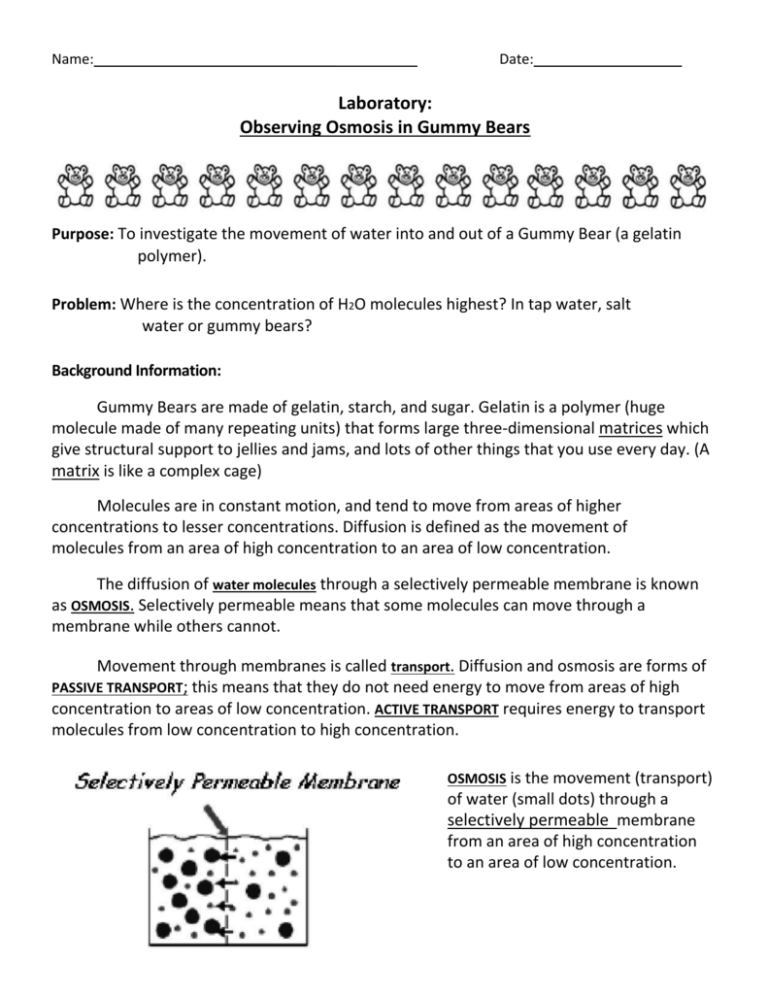
Name:_______________________________ Date:___________________ Laboratory: Observing Osmosis in Gummy Bears Purpose: To investigate the movement of water into and out of a Gummy Bear (a gelatin polymer). Problem: Where is the concentration of H2O molecules highest? In tap water, salt water or gummy bears? Background Information: Gummy Bears are made of gelatin, starch, and sugar. Gelatin is a polymer (huge molecule made of many repeating units) that forms large three-dimensional matrices which give structural support to jellies and jams, and lots of other things that you use every day. (A matrix is like a complex cage) Molecules are in constant motion, and tend to move from areas of higher concentrations to lesser concentrations. Diffusion is defined as the movement of molecules from an area of high concentration to an area of low concentration. The diffusion of water molecules through a selectively permeable membrane is known as OSMOSIS. Selectively permeable means that some molecules can move through a membrane while others cannot. Movement through membranes is called transport. Diffusion and osmosis are forms of PASSIVE TRANSPORT; this means that they do not need energy to move from areas of high concentration to areas of low concentration. ACTIVE TRANSPORT requires energy to transport molecules from low concentration to high concentration. OSMOSIS is the movement (transport) of water (small dots) through a selectively permeable membrane from an area of high concentration to an area of low concentration. Hypotheses: Create a hypothesis for the following solutions. Remember to use the "If...then" format. Hypothesis for water: _________________________________________________________________________ _________________________________________________________________________ _________________________________________________________________________ Hypothesis for salt water: _________________________________________________________________________ _________________________________________________________________________ _________________________________________________________________________ Hypothesis for mystery solution: _________________________________________________________________________ _________________________________________________________________________ _________________________________________________________________________ Materials: Three 100 ml. beakers Masking tape Permanent marker Tweezers Paper towel Gummy Bears Tap water Salt Mystery Solution Ruler Scale Graduated Cylinder Weight Boat Glass stirring rod pH indicator strips Procedure: PARTA: 1. 2. 3. Obtain three beakers, three colored Gummy Bears and a ruler. Label your beaker with a piece of masking tape (folded over) 4. 5. 6. Label one Beaker "TAP WATER", one "SALT WATER", and the other "MYSTERY SOLUTION" Write your name and class period using a permanent marker. Record the color, and texture of the gummy bears and record in the data table 1. Measure your bear (in cm) from top to bottom (length) and from side to side (width) and from front to back (height). 7. 8. 9. 10. Record the dimensions in centimeters in the data table 2. Use decimals. Find the mass of each bear. Record the mass in the data table 3 in grams. Again, use decimals. Place the gummy bears in the beakers. Using a graduated cylinder, measure out 50mL of water and pour into beaker marked for "TAP WATER". The gummy bear should be covered completely. 11. Next, weight out 10g of salt, and pour into a clean beaker. 12. Using a graduated cylinder, measure out 50mL of water and pour into the beaker with the salt. Mix together until the salt dissolves. 13. Pour your salt mixture into the beaker marked "SALT WATER". The gummy bear should be completely covered. 14. Next, measure out 50mL of the mystery solution with a graduated cylinder and pour into the beaker marked "MYSTERY SOLUTION". The gummy bear should be completely covered. 15. Take a glass stirring rod, and dip the end into the beaker with the mystery solution. Test the solution with a pH indicator strip. Record pH here:________________. 16. Place the beakers on the counter away from direct sunlight. 17. Let them sit overnight. PART B: 18. On the next lab day, gently pour the water over a screen into a sink. 19. Catch each gummy bear using your hand, and place the gummy bear on paper towel or waxed paper. BE CAREFUL not to break the bears, they are very fragile. 20. 21. 22. 23. Blot dry by placing bear on a paper towel. Record the color, and texture of each gummy bear in the data table 1. Measure the length, width, and height of each gummy bear and record in data table 2. Carefully place gummy bear on weight boat, and measure it's mass. Record the mass in the data table 3. 24. Place gummy bears back onto paper towel. 25. Calculate the volumes (L × W × H). Data Table 1 Gummy Bear 1 Gummy Bear 2 Gummy Bear 3 Initial Color Initial Texture Initial Color Initial Texture Initial Color Initial Texture Color After Texture After Color After Texture After Color After Texture After Day 1 Day 2 Data Table 2 Gummy Bear 1 Length (cm) Width (cm) Height (cm) Volume (cm3) LxWxH= cm3 Gummy Bear 2 Gummy Bear 3 Initial Final Initial Final Initial Final Before Soaking (Day 1) After Water (Day 2) Before soaking (Day 1) After Salt (Day 2) Before Soaking (Day 1) After Mystery Solution (Day 2) Data Table 3 Gummy Bear 1 Gummy Bear 2 Gummy Bear 3 Initial Final Initial Final Initial Final Before Soaking (Day 1) After Water (Day 2) Before soaking (Day 1) After Salt (Day 2) Before Soaking (Day 1) After Mystery Solution (Day 2) Mass (grams) Analysis: Calculate the percent changes in volume after each step of the experiment. Our scales are accurate to 0.1 gram, therefore your calculations using mass should be rounded to the nearest tenth or 0.1 gram % Change in mass = (Final mass - Initial mass)/ Initial mass × 100 = _________ % Place the percentages in the table below: Data Table 4 Gummy Bears 1 2 3 % Change in water % Change in Salt Water % Change in Mystery Solution Analysis questions: Answer the following using complete sentences. Be sure to restate the question in your answer! 1. Were your hypotheses correct? Why or why not? __________________________________________________________________________ __________________________________________________________________________ __________________________________________________________________________ __________________________________________________________________________ 2. What happened to the bears when placed in water? Why? __________________________________________________________________________ __________________________________________________________________________ __________________________________________________________________________ __________________________________________________________________________ 3. What happened to the bears when placed in saltwater? Why? __________________________________________________________________________ __________________________________________________________________________ __________________________________________________________________________ __________________________________________________________________________ 4. What was the pH of the mystery solution? What did this indicate? __________________________________________________________________________ __________________________________________________________________________ __________________________________________________________________________ __________________________________________________________________________ 5. What happened to the bears when placed in the mystery solution? Why? __________________________________________________________________________ __________________________________________________________________________ __________________________________________________________________________ __________________________________________________________________________ Conclusions: Write a paragraph which explains the results of this experiment using the concept of osmosis. Think about how much swelling can occur (equilibrium). Include your specific data to explain your results and to support your conclusions. ____________________________________________________________________________ ____________________________________________________________________________ ____________________________________________________________________________ ____________________________________________________________________________ ____________________________________________________________________________ ____________________________________________________________________________ ____________________________________________________________________________ ____________________________________________________________________________ ____________________________________________________________________________ ____________________________________________________________________________
